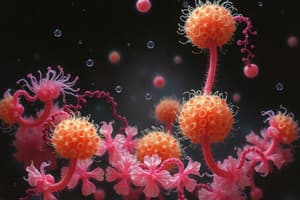Podcast
Questions and Answers
Which scientist is known for demonstrating that spontaneous generation does not exist through proper experimentation?
Which scientist is known for demonstrating that spontaneous generation does not exist through proper experimentation?
- Redi
- Spallanzani
- Pasteur (correct)
- Needham
Heterotrophs are organisms that make their own food.
Heterotrophs are organisms that make their own food.
False (B)
What term describes the ability of an organism to maintain stable internal conditions?
What term describes the ability of an organism to maintain stable internal conditions?
homeostasis
The process by which an organism becomes more complex over time is called ________.
The process by which an organism becomes more complex over time is called ________.
Match the following terms to their corresponding definitions:
Match the following terms to their corresponding definitions:
Which of the following is NOT a characteristic of life?
Which of the following is NOT a characteristic of life?
Asexual reproduction involves two parents.
Asexual reproduction involves two parents.
List two examples of multicellular organisms.
List two examples of multicellular organisms.
Flashcards
Biogenesis
Biogenesis
The process of living things arising from other living things. This means life does not spontaneously arise from non-living matter.
Abiogenesis
Abiogenesis
The process of life arising from non-living matter. This is considered to be false in today's scientific understanding.
Spontaneous Generation
Spontaneous Generation
A theory that states that living things can spontaneously form from non-living matter. This theory is now considered false.
Asexual Reproduction
Asexual Reproduction
Signup and view all the flashcards
Homeostasis
Homeostasis
Signup and view all the flashcards
Heterotroph
Heterotroph
Signup and view all the flashcards
Autotroph
Autotroph
Signup and view all the flashcards
Metabolism
Metabolism
Signup and view all the flashcards
Study Notes
Matching
- Redi: Conducted an experiment disproving spontaneous generation
- Needham: Found organisms in heated broth supporting spontaneous generation
- Spallanzani: Repeated Needham's experiment and found no new life appearing, contradicting spontaneous generation ideas
- Pasteur: Further studied spontaneous generation using S-shaped flasks and disproved it
- Water, space, food, air: Essential components for life
- Autotroph: Organism making its own food
- Multicellular: Organisms made of more than one cell
- Metabolism: Chemical processes within an organism
- Unicellular: Organisms made of a single cell
- Biogenesis: Life comes from life
- Abiogenesis: Life arising from non-living matter
- Asexual reproduction: One parent creates genetically identical offspring
- Heterotroph: Organism that eats other organisms for energy
- Homeostasis: Maintained stable internal conditions (temperature, etc.)
- Response: An action taken by an organism in reaction to a stimulus
- Sexual reproduction: Two parents create genetically diverse offspring
Definitions
- Made of only one cell: Unicellular
- Made of more than one cell: Multicellular
- Living organisms originating from non-living matter (NOT of live birth; NOT formed from life): Spontaneous generation (disproven)
- Genetically identical offspring from one parent: Asexual reproduction
- Organism making its own food: Autotroph
- Stable internal conditions (temperature, waste, nutrients, water etc.): Homeostasis
- Combined chemical processes in an organism: Metabolism
- Organism in reaction to a stimulus: Response
- Biogenesis scientist used S-shaped flask: Pasteur's method to disprove spontaneous generation
- Microorganisms allowed in when the neck of the flask was broken: Pasteur's experiment design
- Two parents creating genetically varied offspring: Sexual reproduction
- Organism eating other organisms for energy: Heterotroph
Examples
- Example of a classmate: (human)
- Example of development: trees and mushrooms
- Example of organisms: Bacteria, archaea, amoebas
- Example of growth: a single cell, strawberry plant
- Example of a heterotroph: a single cell from bacteria
- Example of an autotroph: a plant that can produce its own food.
- Examples of multicellular organisms: trees and mushrooms.
- Examples of unicellular organisms: bacteria, archaea, amoebas
Characteristics of Life (5)
- Cell: Basic structural unit
- Senses: Ability to detect changes in the environment (stimulus)
- Reproduction: Production of offspring to persist
- Growth & development: Organism increases in size or complexity
- Use of energy: Energy is used to function.
Stimulus and Response
- Stimulus (dog): Heat from the sun
- Response (dog): Moving to shade
- Stimulus (squirrel): Being chased by a cat
- Response (squirrel): Climbing a tree
Studying That Suits You
Use AI to generate personalized quizzes and flashcards to suit your learning preferences.




